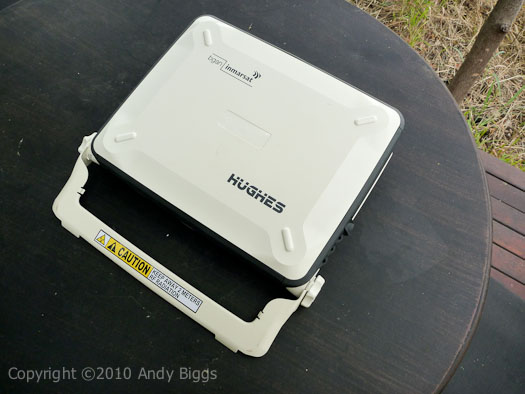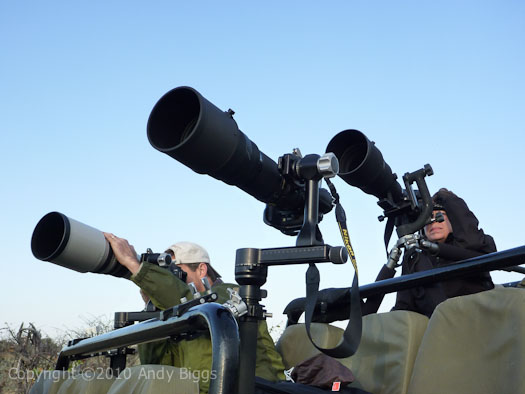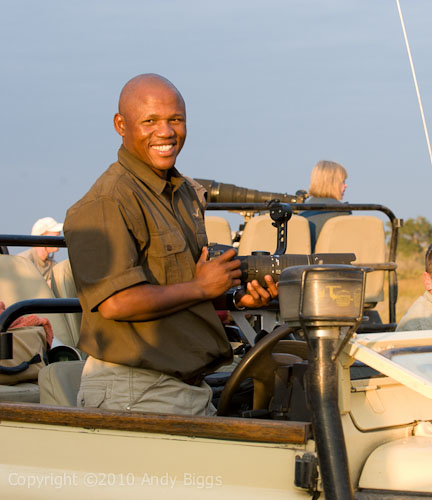Days 10 and 11 – Botswana Safari Summary and 2 days off
 Saturday, August 7, 2010 at 05:54AM
Saturday, August 7, 2010 at 05:54AM I am back in Johannesburg, and I have two days off to reflect on my past safari in Botswana, as well as to do laundry, sleep ‘late’ (to 7am), check up on emails and to hang out with friends. Here are some random thoughts about the safari:
There were 6 Canon shooters and 7 Nikon shooters on the safari, and by far the most popular lenses were the Nikon 200-400mm f/4 VR, the Canon 500mm f/4 and the Canon 100-400mm. This is a common theme on most of my safaris in southern Africa, and my east African safaris typically have a higher number of 500mm and 600mm lenses. The most popular cameras were the Canon 5DMk2 and the Nikon D3 or D3s. Over the past 2 years I have seen a dramatic increase in the number of people who are shooting with Nikon gear, and it is great to see people using Nikon again. Nikon really lost its way for a few years, and I really think that they are offering great equipment for the nature photographer, and I switched back at the end of 2008 because of two reasons: a very good low light solution with the D3 and D700 cameras, as well as the 200-400mm f/4 VR lens.
The weather on the safari was much warmer than anticipated, and most days had a range of around 55F to 85F, which is quite warm for the wintertime. Most days were overcast, which can be a great thing if shooting all day is a goal, however you do give up the warm light at the beginning and end of each day. I have said it before that in my perfect world I would have direct, warm light for the first 90 minutes and last 90 minutes of the day, and overcast and cloudy light for the middle of the day.
Over the past 12 months I have given away all of my slow 4GB and 8GB compact flash cards to my guides as part of their gratuity, so all of my CF cards are now 8GB and 16GB in size. The problem is that I have not moved forward with any new cards and on this safari I had to download my images each day. Typically I will have enough CF cards to last for up to 3 weeks of shooting, and I would download to my laptop when I had the time. On this safari I had to download daily, as well as run 2 different backups each and every day. It isn’t a big deal, but I was busy doing other hospitality related tasks and it meant that my bedtime was pushed much later than normal.
The wildlife on this safari was absolutely fantastic (as usual), and my favorite wildlife moment was our time spent with the African wild dogs. Our watching the dogs hunt, kill, eat and play was my highlight of the year so far. I am turning into more of a birder (yikes!) and I really sank my teeth into better identification of species as well as better photographs. I have been a casual and opportunistic bird photographer in the past, and I have found myself going out to specifically work on my bird photographs as of late. I have been hesitant to post bird photographs in the past, primarily because the birding community is much more aware of deficiencies in the technical aspects of photographs, rather than their creative merits, and I haven’t wanted to mix my own creative view of the world with the those who look for technical deficiencies as their primary form of amusement. Yes, this is a shot across the bow of some bird photographers, and I do wish the bird photography community as a whole would embrace more creative looking photographs and not dwell on errant perches and not-so-perfect feathers. / end rant.
Overall I am extremely happy with the images that I came away with from this safari, and I think my best images will likely be those of leopards. There are a few images that are of portfolio quality, and I will process and post them online when I return back home.
I am looking forward to my next safari in Botswana and South Africa, which I have called my African Wildlife Photography Boot Camp. The safari is designed to be a combination of rich photography with structured education. We will be based out of two different camps: Mashatu Main Camp in the Tuli block of Botswana, and also Rattray’s on Mala Mala in the Sabi Sands in South Africa. We will combine morning and afternoon game drives with mid-day lectures, critiques and slideshows. The goal is for my participants to come back with a better understanding of African wildlife photography, as well as photographs that stir the soul. We will have 4 nights at each camp, and will be utilizing private chartered aircraft (2 of them) in order to be able to carry a ton of gear. Many safaris drive between locations, which loses precious time, and many use normal aircraft, which constricts the amount of weight one can carry. I like to not miss game drives, and I also like to bring the most appropriate camera gear with me, and these private chartered airplanes help facilitate both.

My setup: a D700, D300, 200-400mm and 70-200mm

My connection to the world, the Hughes 9201 Inmarsat BGAN hardware

The mother gunship :-)

...and good guides make all of the difference
 Botswana,
Botswana,  safari in
safari in  Safari Reports
Safari Reports 


Reader Comments (3)
Lets chat about birding after you get back :)
A wonderful overview, Andy. Being a Nikon shooter, I am pleased to see the 200-400 getting so much use in the bush. I will have to take mine on my next safari and move away from the 80-400 Nikon VR that I have been taking to Africa due to weight issues.
Andy...How is Kane? when I saw his picture posted here it reminded me of our great 3 days with him at Savuti Camp this past January...James and Nicky booked my son and I for 14 great days in Bots...we were lucky to have Kane for 3 days to ourselves...he put us on 2 leopards in three days...he is a very impressive guy and his images are first rate...I believe you are helping him with his website?? best of luck...Steve Lumpkin
www.underprairieskies.com